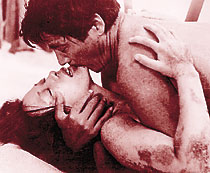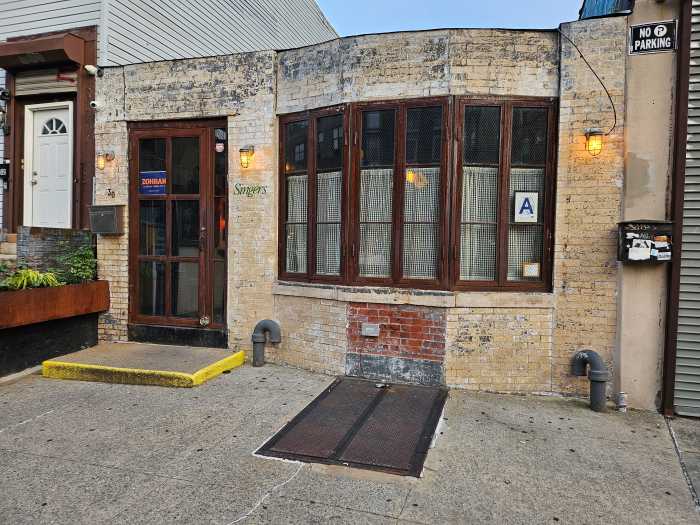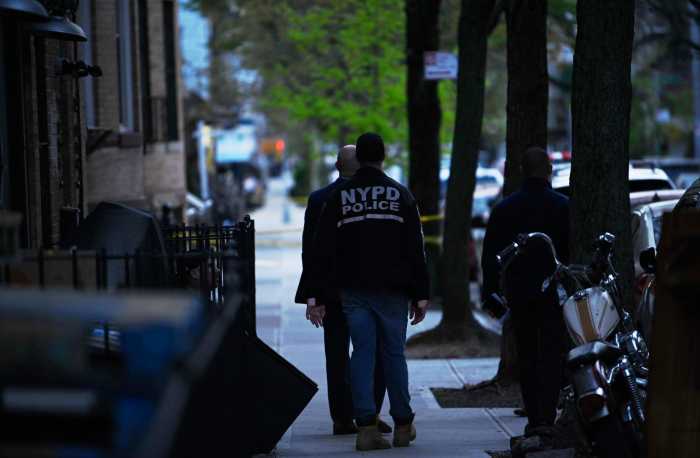Japanese director Hiroshi Teshigahara, who carved out a substantial
niche among art-film fans in the 1960s with his willfully bizarre
and haunting tales of ordinary madness, is the subject of a long-awaited
BAMCinematek retrospective.
"Man in the Dunes: Discovering Hiroshi Teshigahara,"
which plays Feb. 24 through March 19 at the Fort Greene theater,
might be incomplete – only four of the director’s seven features
are being shown, along with one of many documentaries he made
during a fruitful career – but it is necessary viewing for anyone
interested in the enduring, astonishing visions of a true cinematic
artist.
Teshigahara, who died in 2001 at the age of 74, was something
of a Renaissance man. Growing up as the son of a beloved and
famous expert in the Japanese art of "ikebana" (flower
arranging), Teshigahara’s creative life was never limited: along
with being a screenwriter and film director, he was a sculptor,
a painter, an interior designer, a ceramics maker and a stage
director.
But it’s his films that are remembered most highly. And the one
for which he is best known – that masterpiece of eerie sexual
tension and psychological dislocation, "Woman in the Dunes"
– was the second film in a loosely connected quadrilogy of madness
and alienation that Teshigahara collaborated on with two of the
foremost avant-garde Japanese artists of their time: novelist/playwright
Kobo Abe and composer Toru Takemitsu.
When "Woman in the Dunes" was first seen on these shores
after its initial release in 1964, it was in a 124-minute version
that was shortened from its original 147 minutes. Happily, BAMCinematek
will show Teshigahara’s original cut; although the version we’ve
become used to is certainly a major achievement in its own right,
seeing the expansive, two and a half-hour-long version that its
maker originally intended is a breathtaking experience.
The title character of "Woman in the Dunes" lives at
the bottom of a huge sand dune. After a male entomologist stays
too long in the desert and is unable to return home, he ends
up staying with her and becomes slowly enraptured by her.
The film charts the man’s simultaneous descent into madness and
obsessive love as he becomes like the butterflies he studies
– he is literally trapped by her wiles – but there is a difference:
he willingly submits to her.
Shot in rapturous black and white, "Woman in the Dunes"
(which closes the series March 17-19) has been brilliantly edited
by Teshigahara to the otherworldly sounds of Takemitsu’s extraordinarily
effective score. This is "modernist" music at its most
emotionally charged – the rhythmic pounding of the percussion
instruments is often juxtaposed with the romantic sheen coming
from the string section, which creates an eerie aural complement
to the bizarre onscreen goings-on.
Teshigahara’s partnership with Abe and Takemitsu bore fruit four
times. Unfortunately their final collaboration, 1968’s "The
Man without a Map," is not part of this series, but the
other two rarely-seen films are part of the program.
"Pitfall" (March 3-5), Teshigahara’s 1962 debut feature,
tracks the peregrinations of a mysterious white-suited man in
sunglasses who murders members of a remote village freely and
vindictively. His victims, who return as ghosts, are helpless
to affect any change in the behavior of the living.
In "Pitfall," the director created the blueprint for
his later work: luminous black-and-white photography, disturbing
Takemitsu music – which, as always, utilizes silence as much
as sounds – and the incredibly rich imagination of writer Abe.
In many ways, 1966’s "The Face of Another" (March 11-12)
is the most memorable of the Teshigahara-Abe-Takemitsu collaborations.
Playing out like an extended but always compelling "Twilight
Zone" episode, the movie follows a man disfigured in an
accident, and what ensues after he receives a new "face"
from his doctor in place of his own. (Interestingly, a similar
case in France has been in the news recently.)
Played by Kurosawa regular Tatsuya Nakadai with his usual kinetic
energy, the protagonist in "The Face of Another" is
another of Teshigahara’s characters who devolve into a sort of
insanity by encountering situations unlike any they’ve beheld
before.
Playing off the "dual identity" theme, Teshigahara
and his collaborators created another masterpiece of dehumanization,
shown most unsettlingly in the sequence where Nakadai attempts
to seduce his own wife with his new "face" – as another
man.
Two more films round out the series. "Summer Soldiers"
(1972; March 10) is the director’s not entirely successful attempt
to see his own country through the eyes of two American soldiers
serving in Vietnam, who go AWOL and decide to visit Tokyo.
The series’ opening-week film is "Antonio Gaudi," Teshigahara’s
vibrant paean to the great Catalan architect whose amazing designs
in his own hometown of Barcelona – including the flabbergasting
La Sagrada Familia cathedral and Casa Batllo apartment complex
– changed how architecture developed in the early 20th century.
Combining gliding tracking shots through Gaudi’s wondrous buildings
with Takemitsu’s beguilingly offbeat musical score, Teshigahara’s
"Antonio Gaudi" is the ultimate homage to both a great
artist and art itself.
"Man in the Dunes: Discovering
Hiroshi Teshigahara" plays at BAMCinematek, 30 Lafayette
Ave. at Ashland Place in Fort Greene, Feb. 24 through March 19.
Tickets are $10, $7 seniors. For a complete list of screening
dates and times, see the Brooklyn
Events Calendar, call (718) 636-4100 or visit the Web site
at www.bam.org.

























